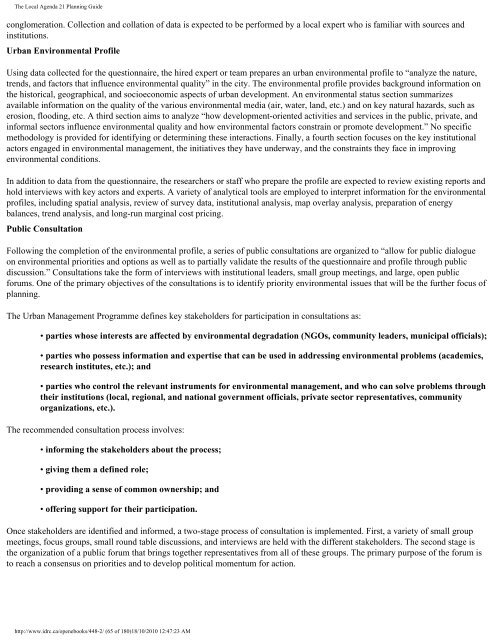The Local Agenda 21 Planning Guide - Democrats Against UN ...
The Local Agenda 21 Planning Guide - Democrats Against UN ...
The Local Agenda 21 Planning Guide - Democrats Against UN ...
Create successful ePaper yourself
Turn your PDF publications into a flip-book with our unique Google optimized e-Paper software.
<strong>The</strong> <strong>Local</strong> <strong>Agenda</strong> <strong>21</strong> <strong>Planning</strong> <strong>Guide</strong><br />
conglomeration. Collection and collation of data is expected to be performed by a local expert who is familiar with sources and<br />
institutions.<br />
Urban Environmental Profile<br />
Using data collected for the questionnaire, the hired expert or team prepares an urban environmental profile to “analyze the nature,<br />
trends, and factors that influence environmental quality” in the city. <strong>The</strong> environmental profile provides background information on<br />
the historical, geographical, and socioeconomic aspects of urban development. An environmental status section summarizes<br />
available information on the quality of the various environmental media (air, water, land, etc.) and on key natural hazards, such as<br />
erosion, flooding, etc. A third section aims to analyze “how development-oriented activities and services in the public, private, and<br />
informal sectors influence environmental quality and how environmental factors constrain or promote development.” No specific<br />
methodology is provided for identifying or determining these interactions. Finally, a fourth section focuses on the key institutional<br />
actors engaged in environmental management, the initiatives they have underway, and the constraints they face in improving<br />
environmental conditions.<br />
In addition to data from the questionnaire, the researchers or staff who prepare the profile are expected to review existing reports and<br />
hold interviews with key actors and experts. A variety of analytical tools are employed to interpret information for the environmental<br />
profiles, including spatial analysis, review of survey data, institutional analysis, map overlay analysis, preparation of energy<br />
balances, trend analysis, and long-run marginal cost pricing.<br />
Public Consultation<br />
Following the completion of the environmental profile, a series of public consultations are organized to “allow for public dialogue<br />
on environmental priorities and options as well as to partially validate the results of the questionnaire and profile through public<br />
discussion.” Consultations take the form of interviews with institutional leaders, small group meetings, and large, open public<br />
forums. One of the primary objectives of the consultations is to identify priority environmental issues that will be the further focus of<br />
planning.<br />
<strong>The</strong> Urban Management Programme defines key stakeholders for participation in consultations as:<br />
• parties whose interests are affected by environmental degradation (NGOs, community leaders, municipal officials);<br />
• parties who possess information and expertise that can be used in addressing environmental problems (academics,<br />
research institutes, etc.); and<br />
• parties who control the relevant instruments for environmental management, and who can solve problems through<br />
their institutions (local, regional, and national government officials, private sector representatives, community<br />
organizations, etc.).<br />
<strong>The</strong> recommended consultation process involves:<br />
• informing the stakeholders about the process;<br />
• giving them a defined role;<br />
• providing a sense of common ownership; and<br />
• offering support for their participation.<br />
Once stakeholders are identified and informed, a two-stage process of consultation is implemented. First, a variety of small group<br />
meetings, focus groups, small round table discussions, and interviews are held with the different stakeholders. <strong>The</strong> second stage is<br />
the organization of a public forum that brings together representatives from all of these groups. <strong>The</strong> primary purpose of the forum is<br />
to reach a consensus on priorities and to develop political momentum for action.<br />
http://www.idrc.ca/openebooks/448-2/ (65 of 180)18/10/2010 12:47:23 AM










